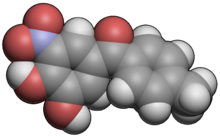Tolcapone
 |
|
 |
|
| Clinical data | |
|---|---|
| Trade names | Tasmar |
| AHFS/Drugs.com | Monograph |
| MedlinePlus | a698036 |
| Pregnancy category |
|
| Routes of administration |
By mouth |
| ATC code | |
| Legal status | |
| Legal status | |
| Pharmacokinetic data | |
| Bioavailability | 65-85% |
| Protein binding | >99.9% |
| Metabolism | Hepatic (glucuronidation) |
| Biological half-life | 2–3 hours |
| Excretion | Urine (60%), faeces (40%) |
| Identifiers | |
|
|
| CAS Number | |
| PubChem CID | |
| IUPHAR/BPS | |
| DrugBank | |
| ChemSpider | |
| UNII | |
| KEGG | |
| ChEMBL | |
| ECHA InfoCard | 100.222.604 |
| Chemical and physical data | |
| Formula | C14H11NO5 |
| Molar mass | 273.241 g/mol |
| 3D model (Jmol) | |
|
|
|
|
Tolcapone (brand name Tasmar) is a drug used to treat Parkinson's disease (PD). It is a selective, potent and reversible nitrocatechol-type inhibitor of enzyme catechol-O-methyltransferase (COMT).
Tolcapone is used in the treatment of Parkinson's disease as an adjunct to levodopa/carbidopa medication that is conventionally paired with an aromatic L-amino acid decarboxylase (AADC) inhibitor.
Normally, administration of levodopa is compromised when COMT converts it to 3-methoxy-DOPA. By preventing this effect, more of the levodopa that is administered reaches the CNS. Additionally, levodopa that is in the CNS, after being converted to dopamine, will not be degraded by COMT when tolcapone inhibits COMT activity.
Tolcapone is a yellow, odorless, non-hygroscopic, crystalline compound with a relative molecular mass of 273.25 g/mol. The chemical name of tolcapone is 3,4-dihydroxy-4'-methyl-5-nitrobenzophenone. Its empirical formula is C14H11NO5.
Tolcapone was introduced into European Market August 1997 and subsequently into the United States Market in March 1998. Liver toxicity or hepatoxicity was reported in four people who were administered tolcapone, 3 people died due to complications. Consequentially, the marketing authorization of tolcapone was suspended from December, 1998 until August, 2004 when it was lifted. In November 1998, the company that manufactured tolcapone voluntarily removed the drug from the market. The authorization was then renewed on August, 2009.
As a result of reported complications, the U.S. Food and Drug Administration (FDA) issued a black box warning for tolcapone and label revisions that aimed to regulate the monitoring of those prescribed tolcapone for PD in November 1998. A number of other countries withdrew tolcapone from the market; Australia in February 1999, Bulgaria in April 1999, Iceland in November 1998, Lithuania in December 1998.
Tolcapone binds to the catalytic center of COMT in both peripheral and central nervous systems with greater affinity than any of the three catecholamine, including levodopa. It thereby prevents the 3-O-methylation of L-DOPA (3-hydroxy-L-tyrosine) by COMT which produces 3-O-methyldopa, a major metabolite that competes with levodopa to cross the blood–brain barrier. Thus, tolcapone improves the bioavailability and reduces the clearance of levodopa and subsequently dopamine from the central nervous system (CNS).
...
Wikipedia
